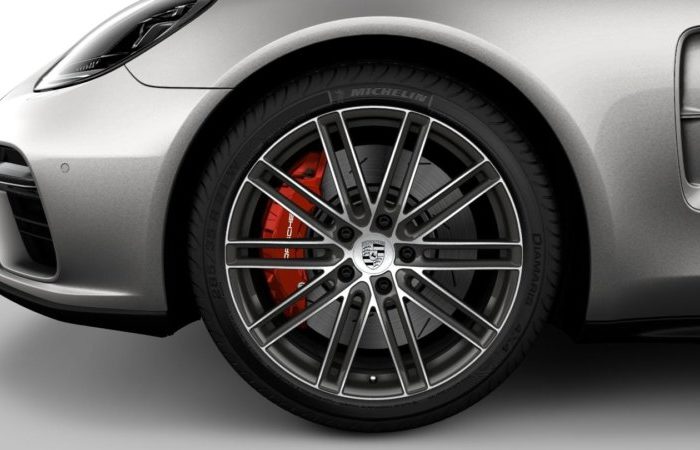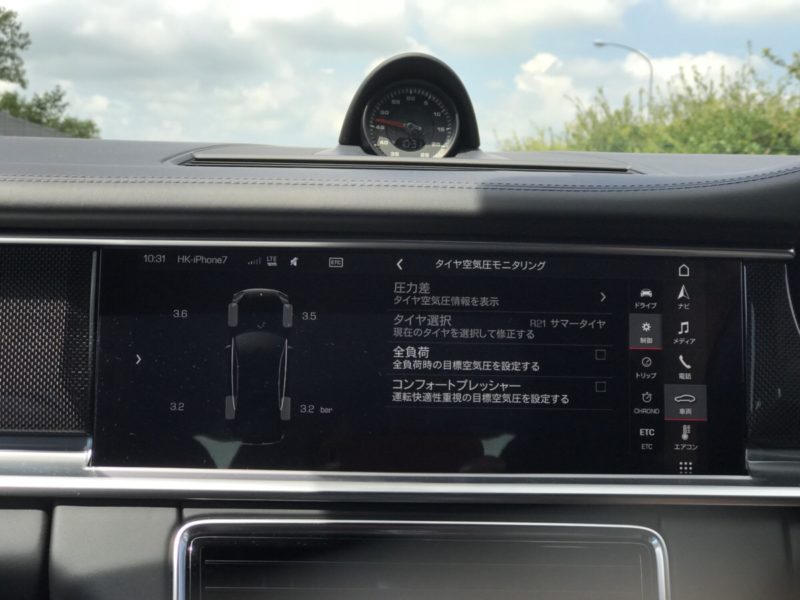How to properly inflate Porsche tires (for models with TPM)
Published on: 17.08.2018

contents
Porsche has air pressure monitors.
In this issue.On how to properly inflate Porsche tires.I wrote. However, I would like to introduce you toIt is a way to inflate the tire pressure for vehicles with a tire pressure monitoring system (hereinafter referred to as TPM).
TPM is a feature available on Porsche 997 and later models.The meter displays the tire pressure for each of the front and rear wheels.They are equipped to detect and warn of slow loss of air pressure, such as spontaneous dissipation, which can cause air pressure loss, or when a foreign object is stuck in the tire, to ensure safety.(Sudden loss of air pressure, such as a flat tire caused by sudden external factors, cannot be detected and will not alert the user.)
So I would like to write this based on our 971 Panamera.
Comfort or standard pressure?
First of all, there is something that must be checked before inflating the tires. That is.Which mode would you like to set the air pressure of your current Porsche to, "Standard Pressure" or "Comfort Pressure"?It is. When you purchase a car, the dealer will often leave it pre-set to either "standard pressure or comfort pressure," so it is a good idea to change the setting to suit your own preferences. Incidentally, there are the following differences
■Standard pressure: Normal Porsche ride quality air pressure. It is set a little harder.
■Comfort pressure: Reduced pressure and slightly softer setting to improve ride comfort
From the touch panel, go to "Vehicle→Controlled Vehicle→Tire Pressure Monitoring" and check "Comfort Pressure" for comfort pressure, and uncheck "Standard Pressure" for standard pressure.

It's important to note here that theComfort pressure is only applicable up to a speed of 160 km/h in Japan, so you will be warned if you exceed 160 km/h.That's what I mean.(270 km/h in Germany and 270 km/h in Japan for the Boxster)I may never go over 160 km/h on Japanese roads, but I'm sure I'll be able toIf you're annoyed by every single warning, it's better to leave it at standard pressure.I think. My family prefers a firmer ride, so we use standard pressure.
How to properly inflate Porsche tires
When inflating tires, the tire pressure is based on the "tire pressure" displayed on the meter, but here is a word of caution.Do not adjust the air pressure based on the "current air pressure display".This means that you should not use a method such as "I want to set the bar to 2.5 bar. For example, "I want to set the bar to 2.5 bar, but the current display is 2.2 bar, so I want to set it to 0.3 bar.
This is because the value on the "current air pressure" display does not take into account the temperature of the tire.It is.(The specified tire pressure is based on 20°C when the tires are cold.)Normally, you would run to a gas station to inflate your tires, but if you do this, the tire temperature rises during the ride, causing the air pressure to increase. If the tires are inflated in this state, the next time the tire temperature drops, it will cause the tires to lose air pressure.
The Panamera manual also states this.
The air pressure display in Tire Pressure -> Current Air Pressure should be used for information only. Tire pressure varies with temperature. Do not adjust tire pressure based on this display under any circumstances.
So what would you base your air pressure adjustment on?"Tire Pressure Deviation" under "Tire Pressure."The value of the "%. The "air pressure deviation" is the difference from the specified pressure of the wheel in question, taking into account the tire temperature.
.jpg)
In the above figure, "-0.1 bar" is indicated at the right rear wheel position. In other words.Refill the right rear tire with 0.1 bar of air.This means. Based on this display, the tire pressure should be adjusted, and if all four tires display "0.0 bar", it is OK.
If you ask the clerk at the gas station to fill it for youYou have to instruct them to "put in another 0.3" instead of "make it 2.8."That is to say.
Air pressure changes driving comfort.
And when I actually drove the car after inflating the air pressure in this way, I found thatThe tires are light, and the rolling resistance is clearly different.On rough surfaces, it may feel a little bouncy, but on flat surfaces it glides and rolls comfortably. Also, when turning a corner at a slightly faster pace, you can feel that the car is firmly standing on the road and there is no sway. My husband was very impressed with the
Speaking of which, when I took delivery of the Boxster, the dealer representative, Mr. H."When adjusting the air pressure, always look at the value on the vehicle, not the value on the meter in the air pump."This is what you were talking about! This is so important!
He said.
Incidentally, the manual states, "Check tire pressure at least once every two weeks when the tires are cold. In our house, it is about once a month, but it seems to be a good idea to check the air pressure frequently, especially during the summer when the air pressure often decreases.
...I've never put in air pressure myself, even though I write this in a big way...(At a gas station, my husband said to me, "Give me 0.1 more! Oh, you put too much! +It's +0.1!" I'm only in charge of saying that.)I am thinking that I will have to try it myself in the future.
Follow me if you like this blog!


Comment ( 0 )
Trackbacks are closed.
No comments yet.